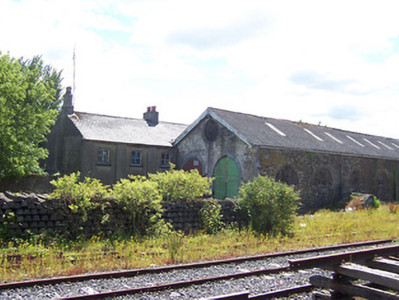Survey Data
Reg No
15310044
Rating
Regional
Categories of Special Interest
Architectural, Technical
Original Use
Train shed
In Use As
Train shed
Date
1848 - 1860
Coordinates
243176, 252564
Date Recorded
07/07/2004
Date Updated
--/--/--
Description
Semi-detached double-height two-bay gable-fronted locomotive shed, built c.1855. Now used to store decommissioned steam locomotives and rolling stock. Pitched corrugated asbestos roof with timber eaves. Constructed of coursed limestone rubble over a dressed limestone plinth with flush ashlar quoins to the corners. Two round-headed carriage arches to front face of each gable end (east and west) having ashlar limestone surrounds and timber sheeted doors with steel fittings. Circular vents to gable apexes above carriage arches. Eight semi-circular windows to the north elevation with brick voussoirs, cut stone sills and multi-paned timber windows. Located to the west of Mullingar Station (15310049) sharing a party wall to the south with the former terrace of railway worker’s houses (15310045). Turntable to west end.
Appraisal
A well-built locomotive shed, which forms part of an important collection of structures associated with Mullingar Railway Station (15310049). This fine structure retains its early form and much of its early fabric, including multi-pane centre-pivoting timber windows. It was originally built by the Midland and Great Western Railway Company to serve the Dublin Broadstone to Galway railway line, which reached Mullingar in 1848 and was completed in 1851. This building is served by twin railway lines, one for each carriage arch, and was originally used for the storage and maintenance of steam locomotives. The lines run through the building and links up with a turntable located to the west end. This turntable is an important survival and it adds substantially to the importance of this composition. This locomotive shed is currently used to store old rolling stock owned by the Railway Preservation Society of Ireland and remains an integral part of the station complex. This locomotive shed was the scene of a notorious murder in 1869 when the Station Master at the time, Thomas Anketell, was shot dead here.

